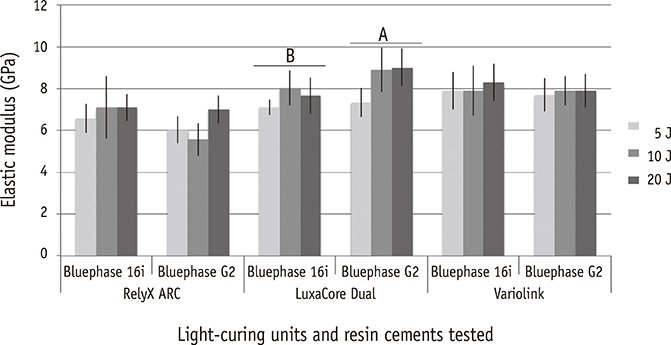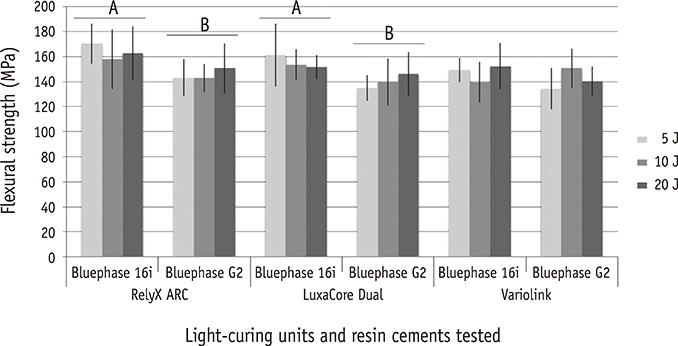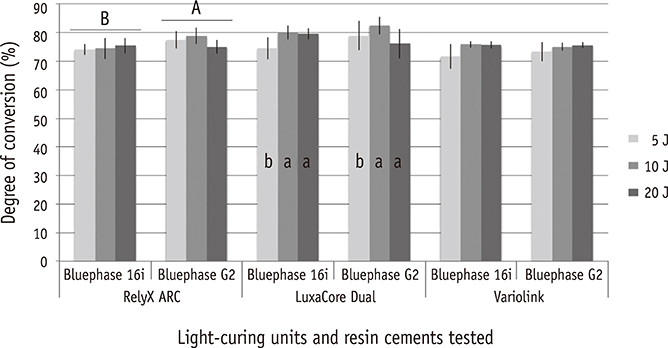Restor Dent Endod.
2016 Nov;41(4):271-277. 10.5395/rde.2016.41.4.271.
Effects of radiant exposure and wavelength spectrum of light-curing units on chemical and physical properties of resin cements
- Affiliations
-
- 1Dental Research Division, School of Dentistry, Paulista University, Sao Paulo, SP, Brazil. lima.adf@gmail.com
- 2Nove de Julho University, São Paulo, SP, Brazil.
- 3Department of Restorative Dentistry, Piracicaba Dental School, University of Campinas, Piracicaba, SP, Brazil.
- 4Department of Restorative Dentistry, Nove de Julho University, São Paulo, SP, Brazil.
- KMID: 2356003
- DOI: http://doi.org/10.5395/rde.2016.41.4.271
Abstract
OBJECTIVES
In this study, we evaluated the influence of different radiant exposures provided by single-peak and polywave light-curing units (LCUs) on the degree of conversion (DC) and the mechanical properties of resin cements.
MATERIALS AND METHODS
Six experimental groups were established for each cement (RelyX ARC, 3M ESPE; LuxaCore Dual, Ivoclar Vivadent; Variolink, DMG), according to the different radiant exposures (5, 10, and 20 J/cm²) and two LCUs (single-peak and polywave). The specimens were made (7 mm in length × 2 mm in width × 1 mm in height) using silicone molds. After 24 hours of preparation, DC measurement was performed using Fourier transform infrared spectrometry. The same specimens were used for the evaluation of mechanical properties (flexural strength, FS; elastic modulus, E) by a three-point bending test. Data were assessed for normality, after which two-way analysis of variance (ANOVA) and post hoc Tukey's test were performed.
RESULTS
No properties of the Variolink cement were influenced by any of the considered experimental conditions. In the case of the RelyX ARC cement, DC was higher when polywave LCU was used; FS and E were not influenced by the conditions evaluated. The LuxaCore cement showed greater sensitivity to the different protocols.
CONCLUSIONS
On the basis of these results, both the spectrum of light emitted and the radiant exposure used could affect the properties of resin cements. However, the influence was material-dependent.
MeSH Terms
Figure
Reference
-
1. Carvalho AP, Turbino ML. Analysis of the microtensile bond strength to enamel of two adhesive systems polymerized by halogen light or LED. Braz Oral Res. 2005; 19:307–311.
Article2. Dunn WJ, Taloumis LJ. Polymerization of orthodontic resin cement with light emitting diode curing units. Am J Orthod Dentofacial Orthop. 2002; 122:236–241.
Article3. Arrais CA, Pontes FM, Santos LP, Leite ER, Giannini M. Degree of conversion of adhesive systems light-cured by LED and halogen light. Braz Dent J. 2007; 18:54–59.
Article4. Jiménez-Planas A, Martin J, Abalos C, Llamas R. Developments in polymerization lamps. Quintessence Int. 2008; 39:e74–e84.5. Jandt KD, Mills RW. A brief history of LED photopolymerization. Dent Mater. 2013; 29:605–617.
Article6. Santini A, Miletic V, Swift MD, Bradley M. Degree of conversion and microhardness of TPO-containing resin-based composites cured by polywave and monowave LED units. J Dent. 2012; 40:577–584.
Article7. Dressano D, Palialol AR, Xavier TA, Braga RR, Oxman JD, Watts DC, Marchi GM, Lima AF. Effect of diphenyliodonium hexafluorophosphate on the physical and chemical properties of ethanolic solvated resins containing camphorquinone and 1-phenyl-1,2-propanedione sensitizers as initiators. Dent Mater. 2016; 32:756–764.
Article8. Meereis CT, Leal FB, Lima GS, de Carvalho RV, Piva E, Ogliari FA. BAPO as an alternative photoinitiator for the radical polymerization of dental resins. Dent Mater. 2014; 30:945–953.
Article9. Schneider LF, Cavalcante LM, Prahl SA, Pfeifer CS, Ferracane JL. Curing efficiency of dental resin composites formulated with camphorquinone or trimethylbenzoyl-diphenyl-phosphine oxide. Dent Mater. 2012; 28:392–397.
Article10. Arrais CA, Giannini M, Rueggeberg FA. Kinetic analysis of monomer conversion in auto- and dual-polymerizing modes of commercial resin luting cements. J Prosthet Dent. 2009; 101:128–136.
Article11. Gaglianone LA, Lima AF, Gonçalves LS, Cavalcanti AN, Aguiar FH, Marchi GM. Mechanical properties and degree of conversion of etch-and-rinse and self-etch adhesive systems cured by a quartz tungsten halogen lamp and a light-emitting diode. J Mech Behav Biomed Mater. 2012; 12:139–143.
Article12. Jandt KD, Mills RW, Blackwell GB, Ashworth SH. Depth of cure and compressive strength of dental composites cured with blue light emitting diodes (LEDs). Dent Mater. 2000; 16:41–47.
Article13. Nakamura T, Wakabayashi K, Kinuta S, Nishida H, Miyamae M, Yatani H. Mechanical properties of new self-adhesive resin-based cement. J Prosthodont Res. 2010; 54:59–64.
Article14. Faria-e-Silva AL, Lima AF, Moraes RR, Piva E, Martins LR. Degree of conversion of etch-and-rinse and self-etch adhesives light-cured using QTH or LED. Oper Dent. 2010; 35:649–654.
Article15. Gaglianone LA, Lima AF, Araújo LS, Cavalcanti AN, Marchi GM. Influence of different shades and LED irradiance on the degree of conversion of composite resins. Braz Oral Res. 2012; 26:165–169.
Article16. Lima AF, de Andrade KM, da Cruz Alves LE, Soares GP, Marchi GM, Aguiar FH, Peris AR, Mitsui FH. Influence of light source and extended time of curing on microhardness and degree of conversion of different regions of a nanofilled composite resin. Eur J Dent. 2012; 6:153–157.
Article17. Lima AF, Soares GP, Vasconcellos PH, Ambrosano GM, Marchi GM, Lovadino JR, Aguiar FH. Effect of surface sealants on microleakage of Class II restorations after thermocycling and long-term water storage. J Adhes Dent. 2011; 13:249–254.18. De Goes MF, Giannini M, Foxton RM, Nikaido T, Tagami J. Microtensile bond strength between crown and root dentin and two adhesive systems. J Prosthet Dent. 2007; 97:223–228.
Article19. Souza-Junior EJ, Prieto LT, Soares GP, Dias CT, Aguiar FH, Paulillo LA. The effect of curing light and chemical catalyst on the degree of conversion of two dual cured resin luting cements. Lasers Med Sci. 2012; 27:145–151.
Article20. Yenisey M, Dede Dö, Rona N. Effect of surface treatments on the bond strength between resin cement and differently sintered zirconium-oxide ceramics. J Prosthodont Res. 2016; 60:36–46.
Article21. Usumez A, Ozturk N, Ozturk B. Two-year color changes of light-cured composites: influence of different light-curing units. Oper Dent. 2005; 30:655–660.22. Rueggeberg FA, Caughman WF, Chan DC. Novel approach to measure composite conversion kinetics during exposure with stepped or continuous light-curing. J Esthet Dent. 1999; 11:197–205.
Article23. Arrais CA, Rueggeberg FA, Waller JL, de Goes MF, Giannini M. Effect of curing mode on the polymerization characteristics of dual-cured resin cement systems. J Dent. 2008; 36:418–426.
Article24. Moraes RR, Faria-e-Silva AL, Ogliari FA, Correr-Sobrinho L, Demarco FF, Piva E. Impact of immediate and delayed light activation on self-polymerization of dual-cured dental resin luting agents. Acta Biomater. 2009; 5:2095–2100.
Article25. Van Landuyt KL, Snauwaert J, De Munck J, Peumans M, Yoshida Y, Poitevin A, Coutinho E, Suzuki K, Lambrechts P, Van Meerbeek B. Systematic review of the chemical composition of contemporary dental adhesives. Biomaterials. 2007; 28:3757–3785.
Article26. Asmussen E, Peutzfeldt A. Influence of selected components on crosslink density in polymer structures. Eur J Oral Sci. 2001; 109:282–285.
Article27. Gonçalves LS, Moraes RR, Ogliari FA, Boaro L, Braga RR, Consani S. Improved polymerization efficiency of methacrylate-based cements containing an iodonium salt. Dent Mater. 2013; 29:1251–1255.
Article28. Andrade KM, Palialol AR, Lancellotti AC, Aguiar FH, Watts DC, Gonçalves LS, Lima AF, Marchi GM. Effect of diphenyliodonium hexafluorphosphate on resin cements containing different concentrations of ethyl 4-(dimethylamino)benzoate and 2-(dimethylamino) ethyl methacrylate as co-initiators. Dent Mater. 2016; 32:749–755.
Article29. Hadis MA, Tomlins PH, Shortall AC, Palin WM. Dynamic monitoring of refractive index change through photoactive resins. Dent Mater. 2010; 26:1106–1112.
Article30. Price RB, Felix CA. Effect of delivering light in specific narrow bandwidths from 394 to 515 nm on the microhardness of resin composites. Dent Mater. 2009; 25:899–908.
Article31. Mainardi Mdo C, Giorgi MC, Lima DA, Marchi GM, Ambrosano GM, Paulillo LA, Aguiar FH. Effect of energy density and delay time on the degree of conversion and Knoop microhardness of a dual resin cement. J Investig Clin Dent. 2015; 6:53–58.
Article32. Reginato CF, Oliveira AS, Kaizer MR, Jardim PS, Moraes RR. Polymerization efficiency through translucent and opaque fiber posts and bonding to root dentin. J Prosthodont Res. 2013; 57:20–23.
Article
- Full Text Links
- Actions
-
Cited
- CITED
-
- Close
- Share
- Similar articles
-
- Evaluation of mechanical properties of several dual-cure resin cements by curing modes
- Light curing of dual cure resin cement
- Effect of infection control barrier thickness on light curing units
- Comparison of light transmittance in different thicknesses of zirconia under various light curing units
- Microhardness of resin cements after light activation through various translucencies of monolithic zirconia





